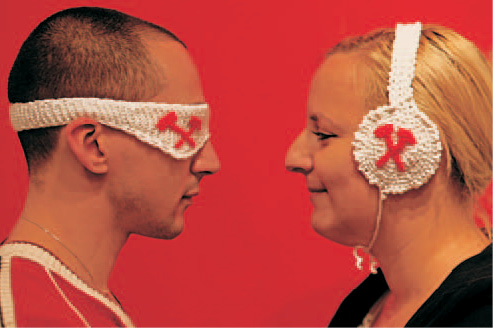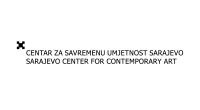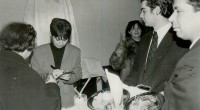Sandra Dukić Boris Glamočanin
 Sandra Dukić was born in 1980. in Rijeka. She graduated at the Academy of Fine Arts in Banjaluka, graphic department, in the class of professor Branko Miljuša. In her works she puts in a focus female identity in the Balkans. She’s worked on several different projects for women’s rights and against female torture. She’s active in humanitary work that considers women in a town Ljubija. Sandra works as a professor of fine art.
Sandra Dukić was born in 1980. in Rijeka. She graduated at the Academy of Fine Arts in Banjaluka, graphic department, in the class of professor Branko Miljuša. In her works she puts in a focus female identity in the Balkans. She’s worked on several different projects for women’s rights and against female torture. She’s active in humanitary work that considers women in a town Ljubija. Sandra works as a professor of fine art.
She participated on:
2002 Ars Aevi “Between” (Sarajevo), 2006 “Continental Breakfast” ( Banjaluka), 2007 Award “Zvono” for contemporary art in Bosnia and Herzegovina, 2007 Dislocation of a View (Banjaluka), 2007 Pitchwise festival of female art (Sarajevo), 2007 Međuprostor, Museum of contemporary art (Novi Sad), 2008 Međuprostor, Culture center Belgrade, 2008 One lično (Zenica), 2008 Get ost (Basel), 2008 Ona i Ono, Muzej Savremene umjetnosti (Banjaluka), 2008 One lično Huizer Museum (Huizen), 2009 Međuprostor, Muzej grada Skoplja, 2010 Keine angst (Leipzig), 2010 NamaTre.ba (Trebinje), 2010 Spaport “Exposures“ (Banjaluka).
Boris Glamočanin was born in 1980. In Zagreb. He graduated the Academy of Fine Arts in Banjaluka, painting department in 2003, in the class of professor Ratko Lalić. Now he is on a master study, also opainting department. Boris is a member of “Protok”, art association in Banjaluka and a member of Association of Artists of the Republic of Srpska. He achieved several awards for his achievement in art work.
Solo exhibitions:
2010 „ Ljubija ubija“ – „Exposures“ SPAPORT 2010, Museum of Contemporary Art, (Banjaluka); 2008 “ONA I ONO”, Museum of Contemporary Art, (Banjaluka); 2007 „Identities“/ instalations, Music pavillio, (Banjaluka); 2004 Exhibition of paintings, Cultural Center Banski dvor, (Banjaluka).
Group exhibitions:
2010 „Wondeland“ Museum of Contemporary Art Casorio, (Napoli); 2009 „Enigma lutke“, National gallery of Bosnia and Herzegovina, (Sarajevo); 2008- 2009 „Međuprostor“, Museum of Contemporary Art, (Banjaluka; Cultural center, Beograd; Museom of Revolution, Novi Sad; Muzeja na grad Skopje, Skopje); 2007 „Dislokacija pogleda“, Museum of contemporary Art RS, Banjaluka, Art association PROTOK, 2007 Salon mladih, Collegium Artisticum, (Sarajevo), 2007 Exhibition ULUBIH, Collegium Artisticum, (Sarajevo), 2006 “Continental Breakfast“ International exhibition of contemporary visual art “ Memory (w)hole“ Museum of contemporary Art RS, (Banjaluka, ART association PROTOK); 2006 Salon mladih“ RS, Gallery Milenko Atanacković, (Bijeljina), 2006 Izložba ULUBIH, Collegium Artisticum, (Sarajevo); 2005 Casoria International Painting Simposium of Young Artist from Europe and the Mediterranean, permanent exhibition – Casoria International Contemporary Museum, (Napoli), 2005 BJCEM-XII Biennial of Young Artist from Europe and Mediterranean Castel Sant’elmo, (Napoli), 2005 Exhibition in Gallery “Roman Petrović” “Sarajevo Winter Festival”, (Sarajevo), 2005 Exhibition ULUBIH, Collegium Artisticum, (Sarajevo), 2005 Exhibition “Halo Bing,kako brat“ national gallery of Bosnia and Herzegovina, (Sarajevo).

”Ljubija Kills”
LJUBIJA
Universal example of a marginalised area, forgotten people and the state’s irresponsibility.
Ljubija used to be a municipality in B&H, and it was a developed region, thanks to the mine, which provided work for the most of the inhabitants. The mine was built during the Austro-Hungarian era, and it was one of the most productive and biggest mines in the Balkans.
During communism the citizens of Ljubija called each other «Mister», «Missis». After work the changed their working clothes with suits and ties and hats.
Most of the settlement was built for the mine workers, with a big number of buildings from 1909.
At the beginning of the war in B&H most of the Ljubija’s inhabitants left. After the war the municipal authorities of Prijedor decided to inhabit Ljubija with refugees and socially jeopardised people. Today, it is a place with 80% rate of unemployment and an example of the most socially jeopardised categories of people. Ljubija has become a reservation for forgotten and abandoned people that nobody speaks of anymore.
The inhabitants live solely on social welfare (which is 45 KM in RS) and child support. Entertainment for the poor is obvious there, so alcoholism is on the rise, prostitution and other different deviant social occurrences.
The project Ljubija has emerged from observing and participating in activist and humanitarian work with women in the community of Ljubija. In our previous works we dealt with the marginalised ones (we consider ourselves the marginalised ones as well) and their identity. Ljubija seemed as a notorious example of a marginalised place, forgotten people and the state’s irresponsibility.
 So.ba – Opening
So.ba – Opening Sarajevo Center for contemporary art (SCCA)
Sarajevo Center for contemporary art (SCCA) Pro.ba
Pro.ba Opening of Soros Center for Contemporary Art Sarajevo
Opening of Soros Center for Contemporary Art Sarajevo